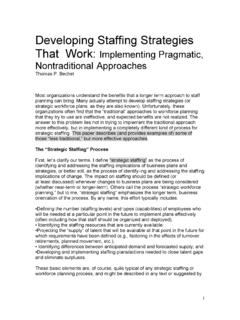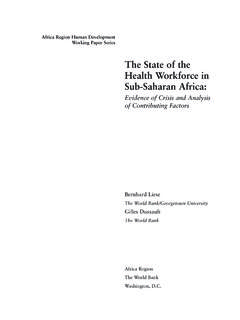Transcription of Taking stock: Health worker shortages and the …
1 In August 2006, the World Health Organization (WHO) launched a coordinated global effort to address a major and often overlooked barrier to preventing and treating HIV: the severe shortage of Health workers, particularly in low- and middle-income Treat, Train, Retain (TTR), the plan is an important component of WHO s overall efforts to strengthen human resources for Health and to promote comprehensive national strategies for human resource development across different disease programmes. It is also part of WHO s effort to promote universal access to HIV/AIDS services. TTR will strengthen and expand the Health workforce by addressing both the causes and the effects of HIV and AIDS for Health workers. Meeting this global commitment will depend on strong and effective Health care systems that are capable of delivering services on a scale much larger than today services depend on having the right people, with the right skills, in the right place.
2 Yet, the world is experiencing a chronic shortage of well-trained Health workers, a crisis felt most acutely in those countries that are experiencing the greatest public Health threats. There are 57 countries, mostly in sub-Saharan Africa but also including Bangladesh, India and Indonesia that face crippling Health workforce shortages . WHO estimates that over 4 million Health workers are needed to fill the gap and the global deficit of doctors, nurses and midwives in particular is no less than million. Sub-Saharan Africa faces the greatest challenges. With % of the world s population and 24% of the global burden of disease, the region has only 3% of the world s Health workers commanding less than % of world Health expenditure. By contrast, the WHO Region of Health worker shortages and the response to AIDSTREAT a package of HIV treatment, prevention, care and support services for Health workers who may be infected or affected by HIV and measures to empower Health workers to deliver universal access to HIV services, including pre-service and in-service training for a public Health strategies to enable public- Health systems to retain workers, including financial and other incentives, occupational Health and safety and other measures to improve the workplace as well as initiatives to reduce the migration of Health care 1 Number of Health care workers (density/p 1000 people) in the WHO regionsData source: World Health Report 2006 Taking stock.
3 Health SyStemS and ServiceS (HSS)TA k I n g S T O Ck2 The face of the crisisthe Americas, with 0% of the global burden of disease, has 37% of the world s Health workers and spends more than 50% of the world s Health mix and distributional imbalances compound today s problems. In many countries, the skills of limited yet expensive professionals are not well matched to the local profile of Health needs and almost all countries suffer from urban concentration and rural deficits. Although, on average, around half of the population lives in rural areas, more than 75% of doctors and over 60% of nurses are to be found in urban reasons for the Health workforce shortage include poor pay and conditions, lack of training and migration. But the problem is particularly complex in those countries most affected by HIV.
4 For where HIV is prevalent, it also contributes to the shortage by rendering the Health workers themselves vulnerable to death and disease. Estimates show that Botswana lost 7% of its Health workforce to AIDS between 999 and 2005. If no action is taken, it is projected that a full 40% of the Health workforce there will die between 999 and 20 0. In Lesotho and Malawi, death from AIDS is the largest cause of Health workforce summary, the response to AIDS depends largely on people who are themselves getting sick and dying. This is why there is now a need for more targeted interventions to support these Health workers, enable them to deliver good care and keep them in their of HIV infection as well as stress and burnout have been shown to cause Health workers to leave active service in HIV-affected 2 Figure 2 illustrates the cause of the Health workforce problem as a work-life cycle of three phases: recruitment, distribution and attrition.
5 There are too few people being trained and enrolled in public- Health systems. Then there is uneven distribution of the pool of skilled workers with high concentrations in urban areas and many working in the private sector rather than in the public- Health service. Many resign due to the pressure of poor working conditions and low pay. Others migrate to better jobs abroad or with the private sector and nongovernmental organizations (ngOs). But the leading cause of attrition is HIV itself. In the countries where HIV is prevalent, huge numbers of skilled Health workers simply fall sick and disease also causes ailing staff to miss work and others to take time out to care for sick relatives. The average worker living with HIV can be absent from work for up to 50% of the expected time in their final year of life.
6 Moreover, fear of HIV infection as well as stress and burnout have been shown to cause Health workers to leave active service in HIV-affected k I n g S T O Ck3TA k I n g S T O CkAntiretroviral therapy and other HIV services save lives. In affluent nations, where treatment has been available since the mid- 990s, there has been a 70% decline in AIDS-related deaths since the introduction of antiretroviral therapy and comprehensive HIV compelling are the data that suggest a direct correlation between higher numbers of Health -service providers and higher rates of access to antiretroviral therapy among those who need it. Table compares antiretroviral therapy coverage rates of 4% in Lesotho, where there are only Health workers per 000 people in need of treatment, to a rate of 5 % in Uganda, which has a much higher density of Health workers per 000 people in need of the and effectCountryNumber of Health service providersNumber of people in need of ARTD ensity (per 1000 people in need of ART)ART coverageLesotho1 21258 530169 534148 1 Density of Health care workers and ART coverageData source: World Health Report 2006 The conclusion seems simple.
7 Improvements in the numbers and skills of the Health workforce could transform the response to HIV and save millions of the Health workforce crisis is an inextricable part of a vicious circle of weak Health systems and weak HIV response. Weak Health systems mean low coverage of HIV services. Prevalence rises, which, in turn, places an increased burden on the Health services. An ailing Health workforce further undermines already weak Health systems and weak Health systems result in an inadequate response to the HIV epidemic (Figure 3).Figure 3 The vicious circleThere are not enough Health workers to deliver on the target of universal access to HIV this background, the need for a plan to strengthen the Health workforce in the context of AIDS and one that is aligned with broader Health systems strengthening has become clear.
8 Indeed, without action on this front, the global commitments to the Millennium Development goals (MDgs), and to providing universal access to HIV services, will almost certainly not be plan must address all three elements of the work-life cycle. This can be achieved by preventing HIV among Health workers and treating those who are infected; expanding the TA k I n g S T O Ck4In May 2006, an international consultation took place in geneva to consider the way forward. It was attended by 34 delegates representing a wide range of governments, international agencies, development agencies, academic institutions and civil society organizations as well as people living with HIV, all of whom are active in the fields of HIV and AIDS as well as human resources for could be assumed that Health workers would be well enough informed to protect themselves from becoming infected with HIV.
9 But this does not seem to be the case. In Swaziland, women make up 80% of the Health workforce and it is estimated that they have the same HIV risk as the general population, where adult prevalence has peaked at From this example it can be seen that Health workers are not immune to the social and environmental factors that assist the sexual transmission of HIV whether this is gender inequality, economic pressures or cultural influences and the majority of infections in Health workers are the result of unprotected sex, Health workers also face risk in the workplace, where they may have contact with infected blood and other body fluids. Each year, 70 000 Health workers worldwide are exposed to HIV, resulting in 000 infections mostly in low- and middle-income countries.
10 Furthermore, WHO estimates that of HIV cases in Health workers around the world are a result of needle-stick injuries. In general, lack of safety equipment such as gloves and safe means to dispose of sharps, as well as a lack of procedures to observe universal precautions, place Health workers at risk of occupational could also be assumed that Health workers would have easy access to Health services should they find themselves in need. Conversely, many Health workers are actually deterred from seeking treatment and support because they fear the attitudes and reactions of colleagues and patients. Many in the field believe that internal stigma is the single most important obstacle to Health workers accessing HIV services. One study suggested that nurses fear disclosure more than they fear infection often than not there is a lack of privacy in consultation and examination situations and Health workers may even find themselves standing in line with their own patients.















